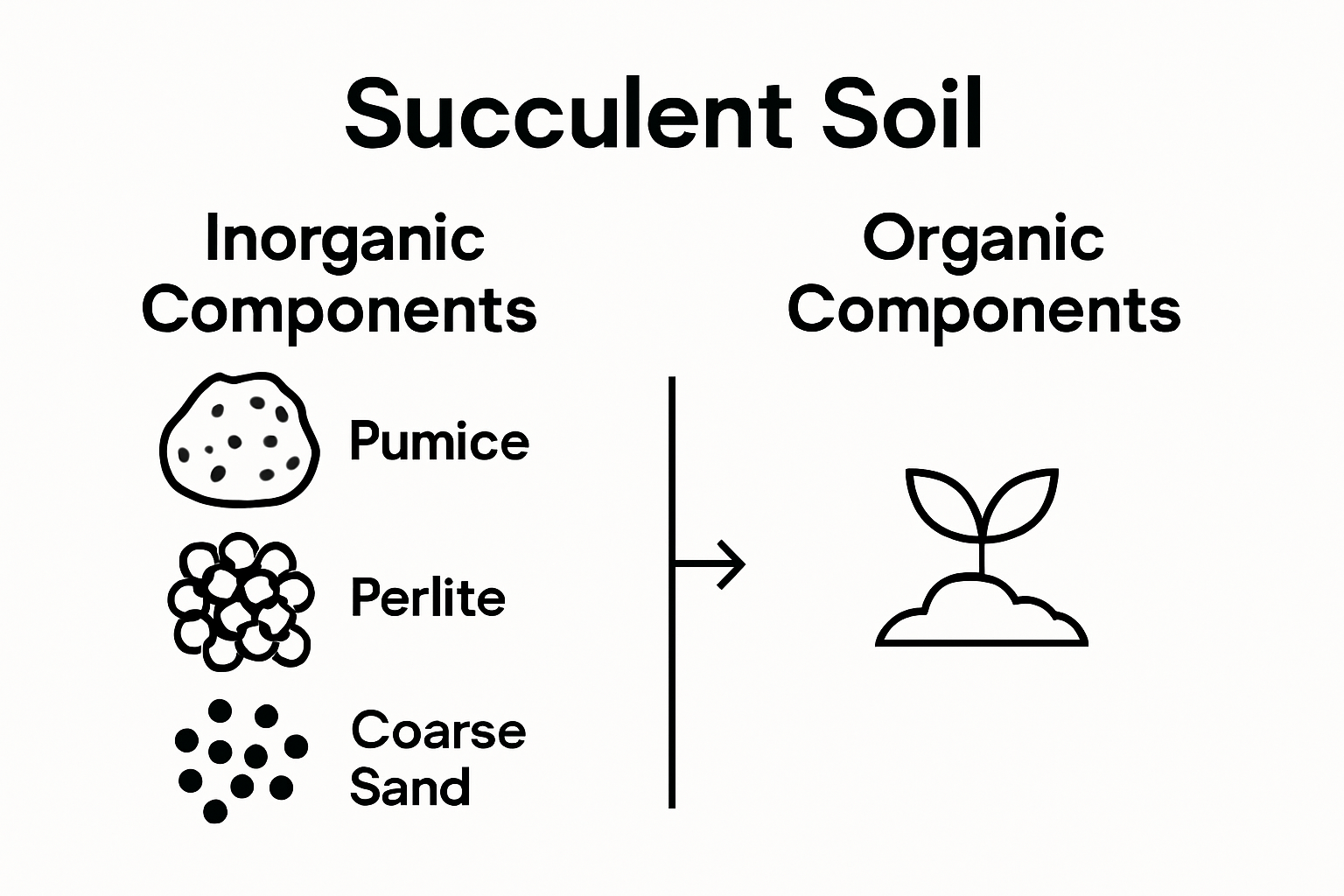Table of Contents
Succulents look nearly indestructible and can survive where most other plants wither. Yet even the toughest cactus can rot if it is planted in regular potting soil. Succulents need a soil mix with about 50% to 80% inorganic material like pumice or coarse sand, which is dramatically different from what most people use. It might sound strict, but using the wrong mix is the fastest way to kill a succulent. The real surprise is how a tiny change in soil ingredients can mean the difference between a plant that flourishes and one that never stands a chance.
Quick Summary
| Takeaway | Explanation |
|---|---|
| Use specialized soil for succulents | A unique growing medium prevents moisture retention and promotes healthy root development. |
| Ideal soil contains 50%-80% inorganic materials | Incorporate pumice, perlite, and coarse sand for optimal drainage and aeration. |
| Low organic matter is crucial | Minimal organic content reduces moisture retention, preventing root rot and fungal growth. |
| Soil composition varies indoors and outdoors | Adjust soil mixtures based on environmental factors like humidity and light exposure. |
| Replicate natural habitat conditions | Creating a soil environment that mimics deserts aids in succulent growth and health. |
What is the Best Soil for Succulents?
Succulent soil represents a specialized growing medium designed to meet the unique drainage and nutritional requirements of these resilient desert plants.
The table below compares the characteristics of standard potting soil with those of ideal succulent soil, to highlight why succulents require a specialized mix.
| Soil Type | Drainage | Organic Content | Inorganic Component (%) | Typical Use |
|---|---|---|---|---|
| Regular Potting Soil | Moderate to low | High | 10%-30% | Most houseplants, flowers, vegetables |
| Ideal Succulent Soil | Rapid, excellent | Low | 50%-80% | Succulents, cacti, drought-resistant plants |
| Unlike traditional potting soils, the best soil for succulents must create an environment that mimics their native arid habitats, allowing roots to breathe and preventing moisture retention that could lead to root decay. |
Understanding Succulent Soil Composition
Succulent soil composition is fundamentally different from regular garden soil. These plants demand a substrate that provides excellent drainage while offering minimal water retention. According to research from the University of California Cooperative Extension, the ideal succulent soil should contain approximately 50% to 80% inorganic materials like pumice, perlite, and coarse sand.
The critical components that define high-quality succulent soil include:
This table summarizes the key components found in high-quality succulent soil and briefly explains the function of each ingredient.
| Component | Purpose |
|---|---|
| Pumice | Enhances drainage and aeration |
| Coarse Sand | Prevents soil compaction, aids quick drainage |
| Perlite | Improves oxygen flow, moderates moisture |
| Minimal Peat | Provides limited nutrients |
| Fine Gravel | Adds structure, helps mimic desert soil |
- Mineral Aggregates: Provide structure and prevent soil compaction
- Low Organic Matter: Reduces water retention and potential fungal growth
- Rapid Drainage Capacity: Allows water to pass through quickly
Why Specialized Soil Matters for Succulent Health
Succulents have evolved in extreme environments where water is scarce and soil conditions are challenging. Their root systems are adapted to quickly absorb moisture and store it efficiently. Using the wrong soil can lead to several complications, including root rot, fungal infections, and stunted growth. Learn more about indoor succulent care to understand how proper soil impacts overall plant health.
The primary goal of specialized succulent soil is to create a growing environment that closely replicates the plants’ natural habitat. By providing a loose, well-draining medium, gardeners can ensure their succulents receive the right balance of minimal moisture and maximum aeration, promoting robust root development and preventing the moisture-related diseases that typically plague these plants in standard potting soils.
Why Soil Composition Matters for Succulents
Succulent plants have remarkable adaptations that make their soil requirements dramatically different from traditional houseplants. The composition of soil directly influences their survival, growth, and overall health, making it a critical factor in successful succulent cultivation.
The Ecological Origins of Succulent Soil Needs
Succulents originate from regions with extreme environmental conditions, primarily arid deserts and rocky landscapes where water is scarce and soil is typically mineral-rich. According to botanical research from the Missouri Botanical Garden, these plants have evolved sophisticated mechanisms to store water in their leaves and stems, which directly correlates with their soil preferences.
The ecological background of succulents highlights why soil composition is crucial:
- Minimal Organic Matter: Reflects their native mineral-dense environments
- Excellent Drainage: Mimics rocky terrain where water quickly passes through
- Low Nutrient Concentration: Prevents excessive growth that could stress the plant
Physiological Impact of Soil on Succulent Health
Poor soil composition can trigger a cascade of health problems for succulents. Excessive moisture retention leads to root rot, fungal infections, and potential plant death. Our comprehensive indoor plant soil guide provides deeper insights into how soil structure affects plant metabolism.
The physiological demands of succulents require a soil environment that provides stability without compromising their delicate water management systems. By understanding and replicating their natural habitat through carefully selected soil components, gardeners can create an optimal growing medium that supports these extraordinary plants’ unique survival strategies.
How Soil Affects Succulent Growth and Health
Succulent soil is not merely a growing medium but a complex ecosystem that directly impacts plant vitality, metabolism, and long-term survival. Understanding the intricate relationship between soil composition and succulent health reveals critical insights into optimal plant care strategies.
Root System Interactions and Soil Dynamics
The root systems of succulents have evolved uniquely to interact with challenging soil environments. According to research published in the Journal of Plant Physiology, these specialized roots function differently compared to traditional plant root structures, prioritizing rapid water absorption and minimal nutrient engagement.
Key interactions between succulent roots and soil include:
- Rapid Moisture Absorption: Efficient water uptake mechanisms
- Minimal Root Expansion: Compact root networks that prevent oversaturation
- Strategic Nutrient Processing: Limited nutrient consumption to maintain metabolic balance
Metabolic Stress and Environmental Adaptation
Inappropriate soil conditions create metabolic stress that can compromise succulent health. Excessive moisture, poor drainage, and high organic content disrupt the plant’s carefully balanced water storage mechanisms. Our comprehensive snake plant soil guide provides additional context on how soil impacts plant metabolism.
Succulents require a soil environment that mimics their natural habitat, allowing them to maintain their extraordinary water conservation strategies. By understanding these complex interactions, gardeners can create soil conditions that support rather than challenge the plant’s inherent physiological processes, ensuring robust growth and long-term plant health.
Key Components of Ideal Succulent Soil
Constructing the perfect soil mixture for succulents requires a strategic approach that balances mineral composition, drainage capabilities, and nutrient availability. The ideal succulent soil is not a one-size-fits-all solution but a carefully engineered growing medium that mimics the plants’ native environmental conditions.
Mineral Composition and Structural Integrity
Succulent soil must provide a foundation that supports root health while preventing water retention. According to soil science research from the University of California Agricultural Extension, the optimal succulent soil should contain a precise mix of inorganic materials that create a lightweight, porous structure.
Critical mineral components include:
- Pumice: Provides exceptional drainage and lightweight structure
- Coarse Sand: Enhances soil aeration and prevents compaction
- Perlite: Improves moisture distribution and root breathing space
Nutrient Balance and Organic Integration
While succulents thrive in mineral-rich environments, the organic content requires careful management. Excessive organic matter can lead to moisture retention and potential root decay. Learn more about plant soil requirements to understand the delicate balance of soil components.
The goal is to create a soil mix that offers minimal nutrients, maximum drainage, and structural stability. By understanding these key components, gardeners can develop a custom soil environment that supports succulent growth, mimicking the harsh yet precise conditions of their native desert habitats.

Real-World Applications of Succulent Soil Choices
Succulent soil selection extends far beyond theoretical considerations, directly impacting plant survival, aesthetic appeal, and long-term cultivation success. Practical application of soil knowledge transforms gardening from a speculative endeavor to a precise horticultural art form that respects each plant’s unique ecological requirements.
Indoor and Outdoor Soil Adaptation Strategies
Succulent soil requirements vary dramatically between indoor and outdoor environments. According to botanical research from the Royal Horticultural Society, environmental factors like humidity, temperature, and light exposure significantly influence soil composition needs.
Key adaptation strategies include:
- Indoor Soil Mix: Higher proportion of inorganic materials
- Outdoor Soil Blend: More complex mineral composition
- Regional Climate Considerations: Customized drainage requirements
Container and Landscape Soil Implementation
The physical context of succulent cultivation demands nuanced soil approaches. Different container types and landscape settings require tailored soil mixtures that support plant health while maintaining aesthetic integrity. Explore sustainable gardening practices to understand holistic plant care approaches.
Successful succulent cultivation requires gardeners to think beyond standard potting techniques, recognizing that soil is a dynamic living system. By understanding the intricate relationship between soil composition and plant physiology, enthusiasts can create microenvironments that not only sustain but allow succulents to thrive in diverse settings.

Take the Next Step Toward Thriving Succulents
You have learned how the right soil makes all the difference for succulent health, growth, and longevity. Many gardeners struggle with root rot, overwatering, and stunted plants because they use soil mixes that trap moisture and neglect vital drainage. Your path toward healthy succulents means choosing soil that echoes their natural, arid habitats and supports robust roots as highlighted in our key insights.
Ready to turn this new knowledge into thriving plants at home? Visit our Plant Care section for easy-to-follow guides and expert tips on succulent soil setup, ongoing maintenance, and common troubleshooting. Explore our main hub at Lushy Gardens for a range of practical advice on everything from container choices to advanced plant care. Make a change today and give your succulents the foundation they need. Start discovering better soil solutions now and watch your plants flourish.
Frequently Asked Questions
What is the best soil composition for succulents?
The ideal soil for succulents should consist of 50% to 80% inorganic materials like pumice, perlite, and coarse sand, allowing for excellent drainage and minimal water retention.
Why is specialized soil important for succulent health?
Specialized soil is crucial as it mimics the succulents’ natural habitat, promoting proper aeration and drainage while preventing issues like root rot and fungal infections associated with moisture retention in standard potting soils.
How does soil affect the growth of succulents?
The right soil composition impacts a succulent’s water absorption and nutrient processing, allowing roots to thrive and minimizing metabolic stress, which can lead to poor health and growth.
What are the key components of ideal succulent soil?
Ideal succulent soil should include mineral aggregates like pumice and coarse sand for structure and drainage, with low organic content to reduce moisture retention, creating an optimal environment for healthy root development.
Recommended
- Master Indoor Succulent Care for a Thriving Collection – Lushy Gardens
- Understanding the Best Indoor Plant Soil for Healthy Growth – Lushy Gardens
- Best Soil for Snake Plant – Cultivating a Healthy Growth Environment – Lushy Gardens
- Understanding the Best Soil for Vegetables: Key Insights – Lushy Gardens
I’m Eleanor, a seasoned gardener with over three decades of experience tending to Mother Nature’s creations. Through Lushy Gardens, I aim to share my wealth of knowledge and help fellow plant enthusiasts uncover the wonders of gardening. Let’s dive into this journey together, one leaf at a time.